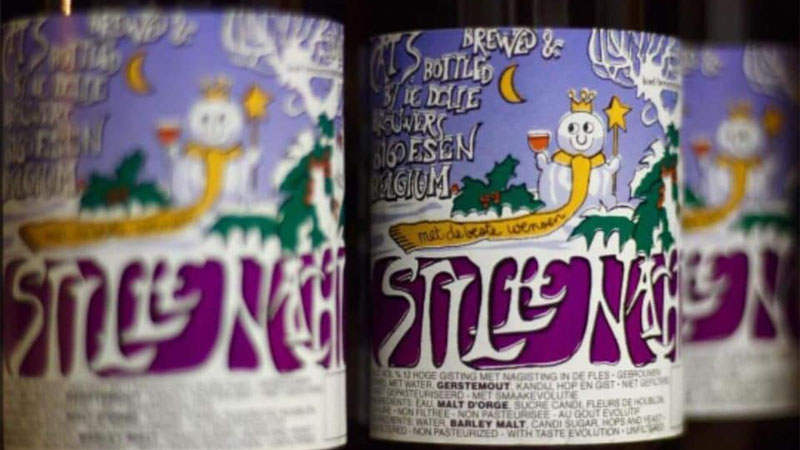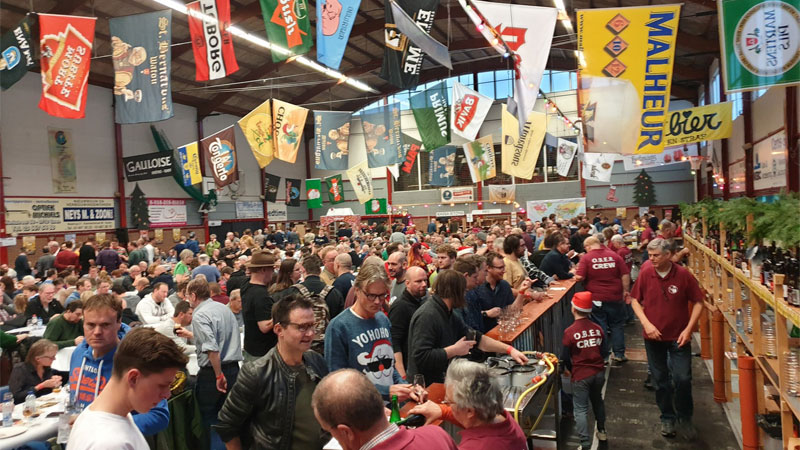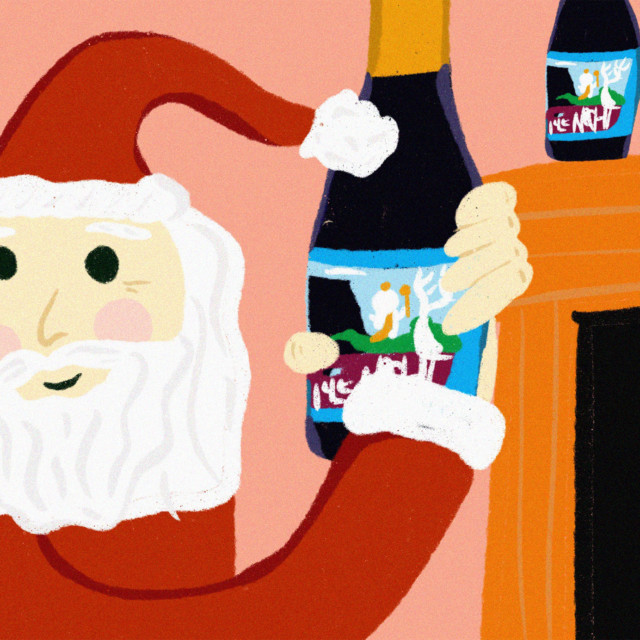VinePair is ringing in the Holiday Cheers with a spotlight on the bottles we’re gifting (and hoping to receive) and a look inside some of our favorite holiday traditions and recipes — from elevated eggnog to all things bubbly. Plus, we’ll be reflecting on the past year in the beverage industry and shifting our focus to the drinks trends we expect to see in 2022.
Despite being Jewish, marriage means I still partake in many of the same annual Christmas rituals as those who celebrate. We bring home a Fraser fir the Friday after Thanksgiving. My daughter and I excitedly open her Advent calendar every evening after dinner. I roast a prime rib on Christmas Day. And, on Christmas Eve night, hopefully after the kids have gone to bed, I always pop a bottle of Stille Nacht.
“Stille Nacht was and still is our prestige beer,” says Kris Herteleer, an architect, painter, local town historian, and the co-founder and brewer for De Dolle Brouwers.
It was 1981 and De Dolle Brouwers (“The Mad Brewers”) had just opened the year before in Esen, located in the Belgian province of West Flanders. This was not a golden era for Belgian beer by any means. Similar to in America, at the time the Belgian market was mostly dominated by conglomerate-owned breweries pumping out bland and often overly sweetened beers.
Herteleer and his brother Jo had been brewing in their garage since they were teenagers, using a copper laundry pot and an extract brewing kit their mother had bought in England. Upon going pro, they would acquire the 150-year-old former space of a brewery that had been closed since World War I.
Their first release would be called Oerbier, meaning “original beer,” a strong dark ale fermented using the house yeast from the legendary Rodenbach Brewery. Its mixed culture included the bacteria Lactobacillus and Pediococcus, meaning the beer would take on a slightly tart flavor as it aged. It was a hit, and the year after, Herteleer started thinking about making a special seasonal beer, as he had never seen one before.
“We thought there were no other Belgian Christmas beers,” Herteleer recalls. He was admittedly aware of the raft of British Christmas beers available at the time, notably Gordon XMas and Young’s Christmas Ale. But he simply hadn’t encountered any Christmas beers being produced in his own homeland, though, as he adds, “We were wrong.”
A Brief History of Christmas Beer
In the early 1900s, certain Belgian breweries had started to label some of their beers as Christmas beers — most of which were stylistic facsimiles of the robust Scotch ales that had long been imported from the British Isles and were quite popular in the country. Like Scotch ales, these Belgium beers would be dark in color, a bit sweet (and sometimes even flavored with holiday spices like cinnamon and cloves), and high in alcohol, all the better to fight off the bitter cold of the season.
Few drinkers today probably realize that the dark and dessert-y Chimay Blue available at many U.S. supermarkets had been born into the world as Chimay Biere de Noël in 1948 before becoming a year-round offering in 1964. (The oft-repeated claim that Stella Artois debuted as a Christmas beer seems a little harder to corroborate.)
Other breweries, like St-Feuillien, would introduce similar beers in the ensuing years, all redolent in their own way of the flavors of Christmas: plums, bread pudding, sticky toffee. Unfortunately for Herteleer, few of these beers were distributed outside their local region at the time, which meant he had never heard of them in his early brewing days.
Nevertheless, Herteleer’s initial Christmas beer attempt, known as Special Brouwsel, would still unwittingly fall within a similar vein flavor-wise, as he essentially brewed a stronger version of his so-called original beer, just using more of the same dark malts.
“The customers here were enthusiastic, and talked about the ‘better Oerbier,’” Herteleer says. But he didn’t like that easy comparison. (“What was so wrong with Oerbier as is?!” he thought.) So, ever the contrarian, in 1983 he opted to brew his Christmas beer with all pale malts instead, then referemented it with honey and dry-hopped it.
He called it Stille Nacht.

Silent Night
On Christmas Eve 1818, Austrian Roman Catholic priest Joseph Mohr took some lyrics he had written to his organist at the parish church, Franz Xaver Gruber, and asked that he compose a melody. It would be first performed at that night’s mass at the St. Nicholas church in Oberndorf, a small village on the Salzach river. The song would quickly spread throughout Europe over the ensuing years and “Stille Nacht” (“Silent Night”) as Mohr titled it, was even performed in New York City as early as 1839.
Herteleer’s Stille Nacht would likewise escape its own country, quickly finding an audience among sophisticated European beer drinkers and especially America’s nascent beer geeks, many who first enjoyed it in the mid-1990s at pioneering bars like the Brickskeller in Washington, D.C. and Monk’s Cafe in Philadelphia. These drinkers would eventually make it a specific part of their own holiday rituals.
“Traditionally in Austria and Germany the Christmas carol ‘Stille Nacht’ is sung only on Christmas Eve, the night it was first performed in Austria,” says “Santa,” the pseudonymous blogger behind ChristmasBeer.net, an entire site dedicated to reviewing the genre. It’s Santa’s favorite Christmas beer, ever since he first had one in 2013, and he agrees there is a specific date it must be drunk every year. “That makes it a Christmas Eve beer.”
It’s almost an unwritten rule for its consumption. Visit Untappd on that night and you’ll see countless other Stille Nacht enthusiasts drinking the quintessential Christmas Eve beer as it’s intended. “This is the most appropriate night to drink this beer,” posts a beer fan in the Netherlands. “A Christmas Eve tradition for the wife and me” posts a Pennsylvania man. “[A] great one to enjoy on Christmas Eve,” posts a drinker in Wisconsin. On several beer advent calendars, it fittingly lurks behind No. 24.
“Christmas Eve without a De Dolle Stille Nacht …would be unthinkable,” claims Dave Atkins, a U.K.-based beer fan. (Of note: You can identify European versions of Stille Nacht by the blue bow across the neck as opposed to the bottle redemption language on American imports.)
Admittedly, many folks do enjoy it on other days, especially past vintages. Herteeler is always sure to “hide” a crate of each year’s release, enabling him to do side-by-side tastings over the years. Many of Belgium’s top beer bars, like Kulminator in Antwerp, likewise keep a supply of yearly vintages so fans can watch how the beer develops over time.
“I enjoy the beer too much to leave it for [Christmas Eve] only,” adds the Christmas beer blogger. “We usually open a few more aged bottles during this season.”
After a couple decades, the cult of Stille Nacht had soared so high that Herteleer was even able to release a limited edition in 2006. Its creation was admittedly a bit of an accident after a portion of 2000’s batch over-fermented and several bottles exploded before shipping out. Herteleer’s only option was to put seven pallets worth of the volatile liquid into some Bordeaux wine barriques.
Six years later, some noted American brewers, like Sam Calagione of Dogfish Head, were touring the brewery when Herteleer remembered the barriques. He finally tasted them along with his brewing luminaries, and everyone was blown away.
“This was a fantastic beer, maybe the best we ever had,” Herteleer recalls. “The American brewers asked what I had done with it. I said, nothing, I had forgotten them.”
He would release the beer as Stille Nacht Reserva 2000, and additional Reserva releases have come out every few years since then, most recently in 2018.

Kerstbierfestival
Since 1995, every December in Essen — different from De Dolle’s Esen — right on the border with the Netherlands, there is the Kerstbierfestival. The two-day festival attracts some 3,000 beer drinkers from over 30 countries who get to sample more than 200 Belgian Christmas beers. This year’s festival was unfortunately postponed due to continuing Covid restrictions, but it’s not too hard to guess which of those beers might have won. Stille Nacht has claimed the Kerstbierfestival title for best Christmas Beer nine separate times, including every single year from 2010 to 2015.
Today, in a world of pastry stout-style Christmas beers loaded with gingerbread, peppermint bark, and even eggnog, Stille Nacht seems downright restrained, a Belgian strong pale ale, high in ABV at 12 percent, though lighter in color than what many expect in a Christmas beer. It is now created from a blend of 10 different batches of beer brewed immediately after Nugget hops arrive from Poperinge in the fall. The sweetness comes from the standard Belgian candi sugar, while a dose of dry hopping balances it out. And, though it lacks any seasonal spices or adjunct additions, it is still, for my money, the best and most singular Christmas beer out there.
In fact, I’ve drank a Stille Nacht every single Dec. 24 since the mid-aughts. On a particularly memorable Christmas Eve in 2013, my future wife and I were actually in Belgium. We bellied up to the bar at Bierbrasserie Cambrinus in Bruges, one of the few places open on that chilly evening. And despite a lengthy bottle list that included Cantillon rarities and multiple vintages of the vaunted Westvleteren 12, there was no question what would be the first thing we ordered.
As Herteleer says:
“A Stille Nacht on Christmas Eve is a must.”
